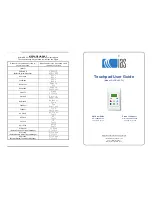
8
INSTALLATION
GENERAL
Please read this guide completely before installation
or use of the modules.
OPERATING CONDITIONS
Panasonic recommends that modules be operated
within the following Operating Conditions. An installa-
tion location with conditions beyond the Operating
Conditions or with other Special Conditions (see
below) should be avoided. Operating Conditions of
Panasonic modules are as follows:
1) The modules should be operated only in terrestrial
applications. No space or other special conditions.
2) The ambient temperature should be within
–
20
°C
to 40°C
.
3) The relative humidity should be within 45% to 95%.
4) The wind pressure load of the installation site
should be less than the load resistance shown in
“
Mount Locations and Load Resistance
”
table in
Figure 1.
SPECIAL CONDITIONS
Panasonic doesn't recommend to install modules in
areas such as below circumstance:
1) The ambient temperature and installation place are
different from the recommended Operating Condi-
tions.
2) Coastal areas where modules come in direct con-
tact with salt water.
3) Heavy snow falls areas.
4) Sand and dust damage is excessive at the installa-
tion place.
Heavy dirt areas by sand or dust (e.g.;
desert, a quarry, etc.)
5) Installation in places where there is a concern
about deterioration of modules such as heavy air
pollution, chemically active vapors, acid rain, and/or
soot, ammonia gas, etc.
UNPACKING AND HANDLING
•
Do not hit
the back sheet of a module by the
connector when unpacking and handling.
•
Please do not expose the connector to rain
water and dust.
•
To avoid the damage of the back sheet
by the
connector, fix the cables to the frame with tape
after unpacking. (refer to Figure 4)
•
Do not handle
modules by their cables or
junction box. Handle them by the frame with
both hands in any situation.
•
The anti
-
reflection glass of the module is easy
to be soiled, when it is grasped by hand or hand
gloves. So it is recommended to hold cardboard
or frames when carrying or installing the solar
module. When cables and connectors touch the
surface of the glass, it may soil the surface too.
It is also recommended to avoid contact of
cables and connectors with surface of the glass.
(If the glass surface becomes dirty, see section
of "anti
-
reflection glass surface cleaning".)
Figure 4. Fixing of cables and con-
nectors




























